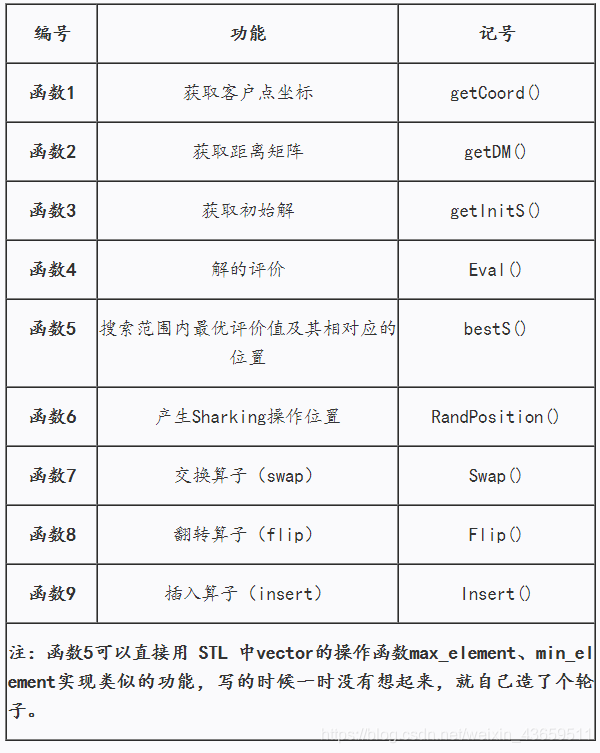隔半年,再次有时间整理关于组合优化问题——旅行商问题(Traveling Salesman Problem, TSP),这次采用的是经典遗传算法(Genetic Algorithm, GA)进行求解,利用C++语言进行编程实现。
各种启发式算法的整体框架大致都由以下几个操作组成:(1)初始解的产生;(2)解的评价(评价函数);(3)扰动算子;此外,还可以加上程序原始数据的导入等操作。这些操作是多数启发式算法所通用的算子,基为此,此次在采用C++进行实现的时候,采用一个通用的 HeuristicOperator.h 头文件以及对应的 HeuristicOperator.cpp 类文件对这些操作进行集中放置,造好轮子,方便以后取用。
【加入我们的学习群(C/C++群:892643663;Java群:957907127),大牛在线为您提供服务,还有免费编译大礼包和视频教程赠送哦】
表1 HeuristicOperator中函数功能清单

之前在采用Matlab以及Java实现GA to solve TSP 时,考虑到程序的运行效率,通常会选用 array 来放置各种数据,众所周知,array的特点就是固定分配的连续物理地址进行数据的存储,然而对于不定长度的数据进行存储时,一般的方式是采用“多次少量”,即预先分配一定内存空间,等不够用了再分配一定的内存空间(多说一句,Matlab 中还可以采用以下两种方式:用 array=[]; 以及用cell实现存储不定长度数组,但效率不高)。而在C++ STL 中有一种神奇的数据类型vector容器,它既有着 array 的连续内存分配方式,又能不用指定数据存储长度,对于一组不同规模的数据集进行测试时,再也不用担心使用array时提醒必须预分配确定的存储空间了~~
以下为HeuristicOperator.h头文件:
#pragma once
#include<iostream>
#include<vector>
#include <algorithm> // std::shuffle
#include <random> // std::default_random_engine
#include<chrono>
using namespace std;
class HeuristicOperator {
public:
vector<vector<double>> getCoord(void); //函数1:获取坐标函数
vector<vector<double>> getDM(vector<vector<double>> Coord); //函数2:获取距离矩阵函数
vector<int> getInitS(int n); //函数3:获取初始解函数
double Eval(vector<int> S, vector<vector<double>> DM, int n); //函数4:评价函数
vector<double> bestS(vector<double> Eval, int Length); //函数5:搜索范围内最优评价值及其相应的位置函数
vector<int> RandPosition(int n); //函数6:产生Sharking操作位置函数
vector<int> Swap(vector<int> S, vector<int> RP); //函数7:交换算子
vector<int> Flip(vector<int> S, vector<int> RP); //函数8:翻转算子
vector<int> Insert(vector<int> S, vector<int> RP); //函数9:插入算子
};
对应的HeuristicOperator.cpp类文件比较容易实现,在此不再赘述。本文所用算例为31城市的TSP问题,与Java版遗传算法求解TSP求解算例一致,具体数据如下:
1304 2312
3639 1315
4177 2244
3712 1399
3488 1535
3326 1556
3238 1229
4196 1004
4312 790
4386 570
3007 1970
2562 1756
2788 1491
2381 1676
1332 695
3715 1678
3918 2179
4061 2370
3780 2212
3676 2578
4029 2838
4263 2931
3429 1908
3507 2367
3394 2643
3439 3201
2935 3240
3140 3550
2545 2357
2778 2826
2370 2975
【加入我们的学习群(C/C++群:892643663;Java群:957907127),大牛在线为您提供服务,还有免费编译大礼包和视频教程赠送哦】
以下为遗传算法的主函数:
/*
文件名:CppGATSP
作者:Alex Xu
地址:Dalian Maritime University
描述:利用遗传算法求解TSP问题
创建时间:2018年12月10日11点27分
*/
#include<iostream>
#include<vector>
#include<numeric> //accumulate
#include<chrono> //time
#include "HeuristicOperator.h"
using namespace std;
using namespace chrono;
//设置算法参数
# define POP_SIZE 2
# define MAX_GEN 4000
int main() {
//计时开始
auto start = system_clock::now();
//生成距离矩阵
HeuristicOperator ga_dm;
vector<vector<double>> GA_DM;
GA_DM = ga_dm.getDM(ga_dm.getCoord());
int n = int(GA_DM[0].size()); //城市规模
//初始化算法
vector<vector<int>> initPop(POP_SIZE, vector<int>(n)); //初始种群
vector<vector<int>> Pop(POP_SIZE, vector<int>(n)); //当前种群
vector<vector<int>> newPop(POP_SIZE, vector<int>(n)); //新种群
vector<double> popFit(POP_SIZE); //记录种群适应度值
vector<int> bestIndival(n); //最优个体
vector<double> gs(MAX_GEN + 1); //记录全局最优解
gs[0] = 1e9;
unsigned int seed = (unsigned)std::chrono::system_clock::now().time_since_epoch().count();
//生成初始种群
HeuristicOperator s0;
for (int i = 0; i < POP_SIZE; i++) {
initPop[i] = s0.getInitS(n);
}
Pop = initPop;
//开始进化
for (int gen = 1; gen <= MAX_GEN; gen++) {
HeuristicOperator eval; //计算种群的适应度值(这里直接用路径长度表示)
for (int i = 0; i < POP_SIZE; i++) {
popFit[i] = eval.Eval(Pop[i], GA_DM, n);
}
HeuristicOperator bestEI; //找出种群中个体的最优适应度值并记录相应的个体编号
vector<double> bestEvalIndex(2);
bestEvalIndex = bestEI.bestS(popFit, POP_SIZE);
double bestEval = bestEvalIndex[0]; //最优适应度值
int bestIndex = int(bestEvalIndex[1]); //最优适应度值对应的个体编号
//最优解的更新
if (bestEval < gs[gen - 1]) { //比上一代优秀则更新
gs[gen] = bestEval;
bestIndival = Pop[bestIndex];
}
else { //不比上一代优秀则不更新
gs[gen] = gs[gen - 1];
}
if (gen % 100 == 0) {
cout << "第" << gen << "次迭代时全局最优评价值为" << gs[gen] << endl;
}
//扰动操作(产生新种群)
for (int p = 0; p < POP_SIZE; p++) {
HeuristicOperator shk;
vector<int> randPosition = shk.RandPosition(n);
vector<int> tmpS(n);
double randShk = rand() / double(RAND_MAX);
if (randShk < 0.33) {
tmpS = shk.Swap(Pop[p], randPosition); //交换操作
}
else if (randShk >= 0.67) {
tmpS = shk.Flip(Pop[p], randPosition); //翻转操作
}
else {
tmpS = shk.Insert(Pop[p], randPosition); //插入操作
}
HeuristicOperator evl;
if (evl.Eval(tmpS, GA_DM, n) > evl.Eval(Pop[p], GA_DM, n)) {
newPop[p] = Pop[p];
}
else {
newPop[p] = tmpS;
}
}
Pop = newPop;
//选择操作(轮盘赌)
vector<double> Cusum(POP_SIZE + 1, 0); //适用于轮盘赌的累加器Cusum(补充了cus[0]=0;
for (int i = 0; i < POP_SIZE; i++) {
Cusum[i + 1] = Cusum[i] + popFit[i];
}
double Sum = accumulate(popFit.begin(), popFit.end(), 0.0); //计算各个体被选择的概率(归一化)
vector<double> cusFit(POP_SIZE + 1); //放置种群中个个体被选择的概率值
for (int i = 0; i < POP_SIZE + 1; i++) {
cusFit[i] = Cusum[i] / Sum;
}
for (int p = 0; p < POP_SIZE; p++) { //轮盘赌产生新种群
double r = rand() / double(RAND_MAX);
for (int q = 0; q < POP_SIZE; q++) {
if (r > cusFit[q] && r <= cusFit[q + 1]) {
newPop[p] = Pop[q];
}
}
}
Pop = newPop;
}
//计时结束
auto end = system_clock::now();
auto duration = duration_cast<microseconds>(end - start);
cout << "花费了"
<< double(duration.count()) * microseconds::period::num / microseconds::period::den
<< "秒" << endl;
//输出结果
double gs0 = 15377.711;
cout << "最优解为" << gs[MAX_GEN] << endl;
double e = (gs[MAX_GEN] - gs0) / gs0;
cout << "误差为" << e * 100.0 << '%' << endl;
cout << "最优路径为" << endl;
for (int i = 0; i < n; i++) {
cout << bestIndival[i] + 1 << '\t';
}
while (1)
{}
}
以上即为C++语言所编写的遗传算法求解TSP示例,运行环境为:Windows10 64位操作系统;CPU:i7-8750H; 内存:8G;Microsoft Visual Studio Community 2017 。求解结果如下:

与已知最优解的误差为1.48%,所用时间约为3.6s. 还可以接受。但值得注意的是:本文实验参数最大迭代次数4000代,而种群规模仅为2,这与一般的遗传算法思想上是没问题的,只是实际参数可能不太符合。当然,对于算法参数这些细节都是可以调节的,不必太过于纠结。
啊哈,这次的利用C++编程遗传算法求解TSP就这些了~~~
【加入我们的学习群(C/C++群:892643663;Java群:957907127),大牛在线为您提供服务,还有免费编译大礼包和视频教程赠送哦】